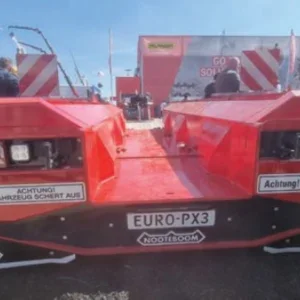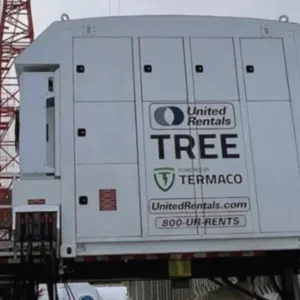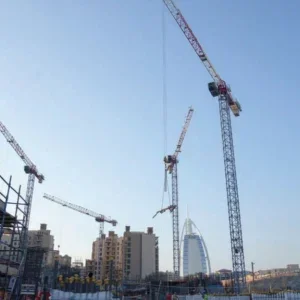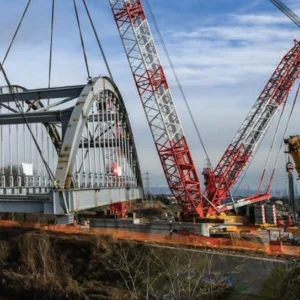At Budapest Ferihegy International Airport, the airport serving the Hungarian capital, the three-storey Sky Court passenger building is being built to connect Terminal 2A and Terminal 2B. The project involves the construction of 40,000 sq m of new terminal area and the complete refurbishment of 55,000 sq m of existing facilities. It includes a pier featuring eight new aeroplane jetties, with a second pier with a further eight jetties to be built in the future.
For this work, Ács-Gép is employing a Liebherr 420 EC-H16, with a hook height of 60.8m, a jib length of 60m and 16t maximum lifting capacity; a second 420 EC-H16, with a hook height of 43.4m, a jib length of 60m and 16t maximum lifting capacity; a Liebherr 280 EC-H12, with a hook height of 27.7m, a jib length of 75m and a 12t maximum lifting capacity; twoWilbertWT200 e.tronic models, one with a hook height of 30m and the other with a hook height of 34m, and both with a jib length of 35m and an 8t maximum lifting capacity; a thirdWT200, with a hook height of 20.5m, a jib length of 62.5m and a 8t maximum lifting capacity; and a Wilbert WT420 e.tronic with a hook height of 32m, a jib length of 35m and a 16t maximum lifting capacity.
The two 420 EC-H16s and two of the WT200s are being used to construct the main monolithic structure, with the two 420 ECH-16s and theWT420 working on the steel roof. The roof will form a lattice structure and each beam will be assembled in three sections. This will see two of the tower cranes and a 500t Terex- Demag AC 500 SSL mobile crane performs a three-way lift. A 420 EC-H16 will lift and transfer the first section to the WT420, before lifting the second section into position. The AC 500 will then lift the third section into position, and the three cranes will hold the sections in place while they are fixed together.
The pier and jetties are being built using the 280 EC-H12 and aWT200.
Ács-Gép says the primary concern for specifying the cranes was that they could lift the 12t beams of the roof structure alone or in tandem lift operations. Another issue was working in a flight path, which saw the cranes’ components painted red and white, and aviation lighting systems installed. They have also been fitted with electronic operating range limiting systems to stop them interfering with the flow of planes to and from the airport.
In Budapest itself, Ács-Gép’s tower cranes are being used in Hungary’s current biggest construction project, the Köbánya-Kispest (KÖKI) Terminal. The KÖKI Terminal is a five storey-high, 62,000 sq m shopping mall featuring a traffic junction including a bus station, a train station and an underground station. Some 14 tower cranes from Ács- Gép’s fleet, Liebherr and Wolffkran models, are at work on site, with lifting capacities from 6t up to 12t, and hook heights from 31.3m up to 64.5m.
Every crane has been erected on foundation anchors at the base of structure, and is being used to lift and move steel and concrete as the structure is built up. They are currently working to a one-shift pattern but, as the job progresses; they will switch to 24-hour operation to ensure the project meets its 2010 deadline. Organising the crane operators has been the biggest challenge for Ács-Gép, as the volume of cranes means some working radiuses overlap. This will become harder as the cranes switch to a 24-hour work pattern, Ács-Gép says.






